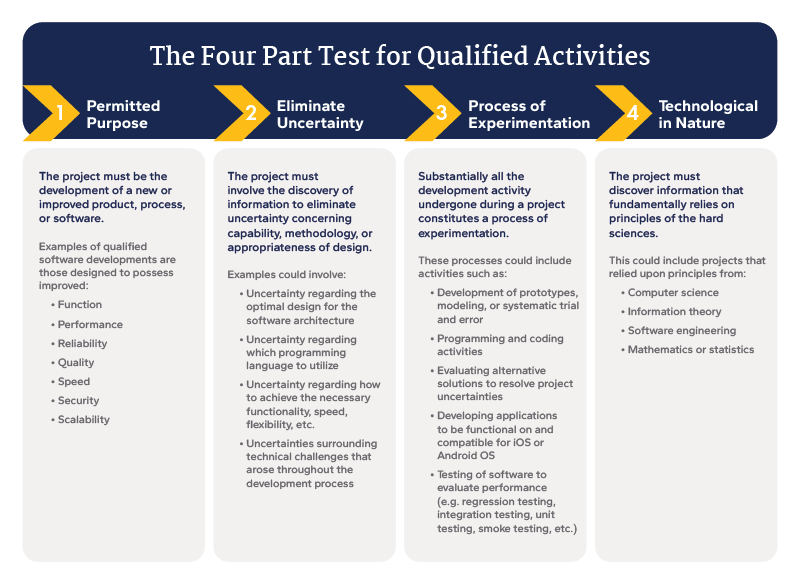Key Takeaways
- The R&D tax credit offers significant financial benefits to software development companies participating in certain research and development activities.
- If software is categorized as Internal Use, it must satisfy both the four-part test and the High Threshold of Innovation test to qualify for the R&D tax credit.
- Eide Bailly offers specialized guidance to help software development companies navigate and maximize benefits from the R&D tax credit.
Software development companies must continually innovate to remain competitive in the ever-evolving technology landscape. The research and development (R&D) tax credit incentivizes innovation by rewarding companies that participate in certain activities related to the development of new or improved products, processes, and techniques.
For software developers looking to get and stay ahead in a highly competitive market, leveraging R&D tax incentives is not just advantageous — it's essential.
In addition to the federal tax credit, many states have their own R&D credits or incentives. These incentives offer several benefits, including:
- Immediate source of cash and reduction in current-year tax.
- Source of permanent tax savings and financial statement benefits.
- Increase in market value, cash flow, and company ROI.
Qualifying Software Development Activities and the R&D Tax Credit
Because software development is experimental in nature, many activities could be eligible for the R&D tax credit. To qualify, a project must satisfy the four-part test outlined in Section 41(d) of the IRC.
For software development companies, these qualifying activities may include:
- Enhancement of software to improve function, performance, reliability, speed, security, and/or scalability.
- Automation and/or streamlining of internal processes.
- Testing of software to evaluate performance (e.g., regression testing, integration testing, unit testing).
- Evaluating alternative solutions to resolve project uncertainties.
- Developing applications to be functional and compatible with iOS or Android OS.

Internal vs. External Use Software and the R&D Tax Credit
Software can fall into one of three categories based on its intended uses and purpose: external use, dual use, or internal use. Depending on which category a software falls into, it may need to meet different criteria to qualify for the R&D tax credit.
External-Use Software
External-use software (EUS) is developed to be sold, leased, licensed, or marketed to third parties. Examples of EUS include Software as a Service (SaaS) products and mobile apps. EUS is generally considered a qualifying research activity for the R&D tax credit so long as it meets the standards of the four-part test above.
Internal-Use Software
Internal-use software (IUS) is developed primarily for use by the taxpayer who creates it. In 2015, the U.S. Treasury Department released new regulations regarding IUS and its eligibility for the R&D tax credit.
The clarification around IUS, now defined by the IRS as software used in general and administrative functions (such as financial management, recordkeeping, HR management, or support services), enables more software developers to claim R&D-based tax incentives.
In addition to the four-part test, IUS must satisfy the High Threshold of Innovation test to qualify for the R&D tax credit. In this test, software created for internal use must:
- Be Innovative: The software is developed to result in reductions in cost or improvements to speed that are substantial and economically significant.
- Involve Significant Economic Risk: The taxpayer committed substantial resources to the development of the software, and due to technical risk, there is significant uncertainty that it will recover the resources in a reasonable period.
- Not Be Commercially Available: The developed software cannot be purchased, leased, or licensed and cannot be used for the intended purpose without modifications.
Dual Use Software
Dual-use software is an IUS that contains features for both internal and external use, such as customer service portals and cloud-based project management tools.
To qualify for the R&D tax credit, dual-use software must pass both the four-part test and the 3-Part High Threshold of Innovation Test.
How Eide Bailly’s R&D Tax Credit Team Can Help
Companies that create new or enhance existing software can benefit from the R&D tax credit; however, few are taking full advantage of this highly lucrative incentive. With experience in federal and state R&D tax credit rules, criteria, code, and regulations, Eide Bailly’s Research & Development Tax Credit Team can help you navigate and benefit from Section 174 and R&D — empowering you to invest more in innovation and stay ahead in your field.
R&D Tax Credit Calculator

R&D Tax Incentives
Turn your innovation efforts into tax savings with the help of a trusted advisor.
Technology
Helping you optimize your processes, satisfy regulatory requirements, invest wisely, and grow.
Who We Are
Eide Bailly is a CPA and business advisory firm helping our clients grow, thrive, and embrace opportunities and innovation.


